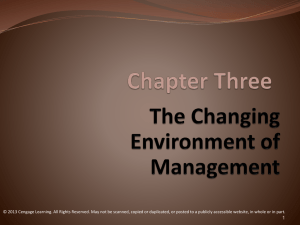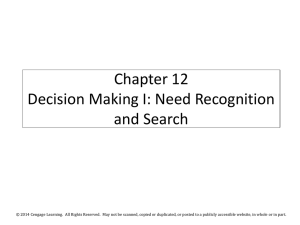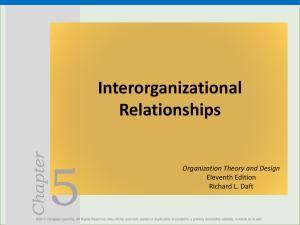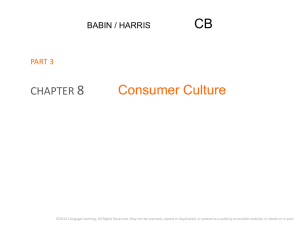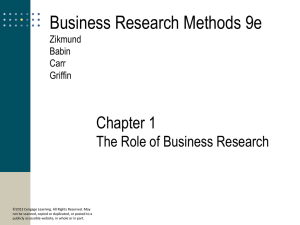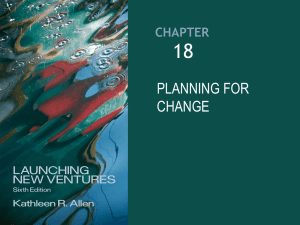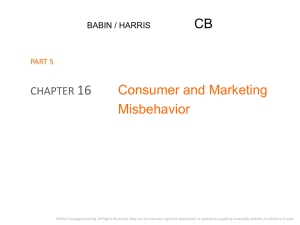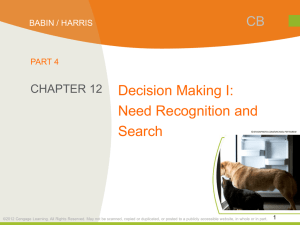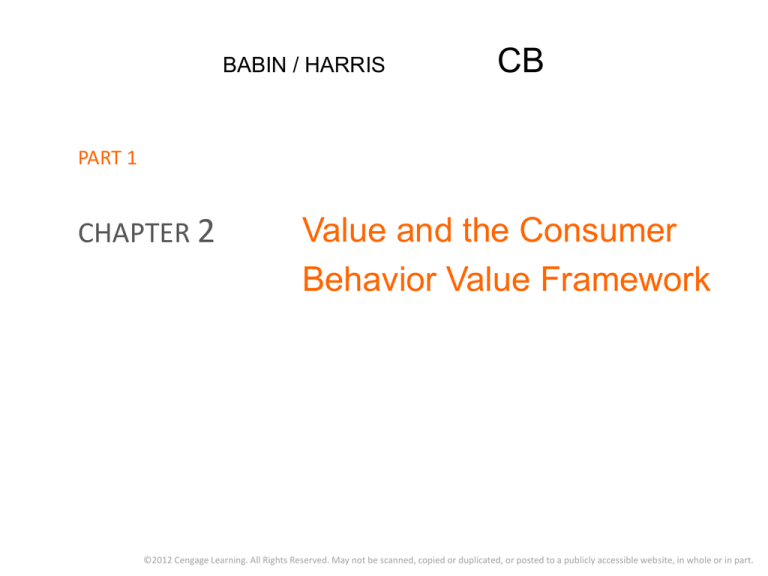
BABIN / HARRIS
CB
PART 1
CHAPTER 2
Value and the Consumer
Behavior Value Framework
©2012 Cengage Learning. All Rights Reserved. May not be scanned, copied or duplicated, or posted to a publicly accessible website, in whole or in part.
Learning Outcomes
1.
Describe the consumer value framework, including its basic
components.
2.
Define consumer value and compare and contrast two key types of
value.
3.
Apply the concepts of marketing strategy and marketing tactics to
describe the way firms go about creating value for consumers.
4.
Explain the way market characteristics like market segmentation and
product differentiation affect marketing strategy.
5.
Analyze consumer markets using elementary perceptual maps.
6.
Justify consumers’ lifetime value as an effective focus for long-term
business success.
2-2
©2012 Cengage Learning. All Rights Reserved. May not be scanned, copied or duplicated, or posted to a publicly accessible website, in whole or in part.
The Consumer Value Framework
(CVF)
• Represents consumer behavior theory
illustrating factors that shape consumption
related behaviors and ultimately
determine the value associated with
consumption.
LO1
2-3
©2012 Cengage Learning. All Rights Reserved. May not be scanned, copied or duplicated, or posted to a publicly accessible website, in whole or in part.
Value and the CVF Components
• Value is at the heart of experiencing and
understanding consumer behavior.
• Components of the CVF:
•
•
•
•
LO1
Relationship quality
Consumption process
Internal influences
External influences
2-4
©2012 Cengage Learning. All Rights Reserved. May not be scanned, copied or duplicated, or posted to a publicly accessible website, in whole or in part.
Customer Relationship
Management
• A systematic management information
system that collects, maintains, and
reports detailed information about
customers to enable a more customer
oriented approach.
LO1
2-5
©2012 Cengage Learning. All Rights Reserved. May not be scanned, copied or duplicated, or posted to a publicly accessible website, in whole or in part.
Relationship Quality
• Reflects the connectedness between a
consumer and a retailer, brand, or service
provider.
• High perceived value improves relationship
quality.
LO1
2-6
©2012 Cengage Learning. All Rights Reserved. May not be scanned, copied or duplicated, or posted to a publicly accessible website, in whole or in part.
Consumption Process
•
•
•
•
•
Needs
Wants
Exchange
Costs and benefits
Reactions
LO1
2-7
©2012 Cengage Learning. All Rights Reserved. May not be scanned, copied or duplicated, or posted to a publicly accessible website, in whole or in part.
Internal Influences
• Things that go on inside the consumer or
that can be thought of as part of the
consumer.
• The psychology of the consumer.
• The personality of the consumer.
LO1
2-8
©2012 Cengage Learning. All Rights Reserved. May not be scanned, copied or duplicated, or posted to a publicly accessible website, in whole or in part.
Psychology of the Consumer
• Cognition—the thinking or mental
processes that go on as we process and
store things that can become knowledge.
• Affect—refers to the feelings experienced
during consumption activities or
associated with specific objects.
LO1
2-9
©2012 Cengage Learning. All Rights Reserved. May not be scanned, copied or duplicated, or posted to a publicly accessible website, in whole or in part.
Personality of the Consumer
• Every consumer has certain characteristics
and traits that help define them as an
individual.
• Individual differences—include things like
personality and lifestyle.
LO1
2-10
©2012 Cengage Learning. All Rights Reserved. May not be scanned, copied or duplicated, or posted to a publicly accessible website, in whole or in part.
External Influences:
Interpersonal Influences
• External influences include the social and
cultural aspects of life as a consumer.
• Social environment includes the people and
groups who help shape a consumer’s
everyday experiences.
• Situational influences are things unique to a
time or place that can affect consumer
decision making and the value received from
consumption.
LO1
2-11
©2012 Cengage Learning. All Rights Reserved. May not be scanned, copied or duplicated, or posted to a publicly accessible website, in whole or in part.
Value
• A personal assessment of the net worth
obtained from an activity.
• Value = What you get – What you give
• Utilitarian value—how the consumer
solves jobs that come along with being a
consumer.
• Hedonic value—the immediate
gratification that comes from experiencing
some activity.
LO2
2-12
©2012 Cengage Learning. All Rights Reserved. May not be scanned, copied or duplicated, or posted to a publicly accessible website, in whole or in part.
Marketing Strategy
• The way a company goes about creating
value for customers.
• Strategy exists at several levels:
• Corporate strategy—deals with how the firm
will be defined and setting general goals.
• Marketing strategy follows.
• Marketing tactics—ways marketing
management is implemented (price,
promotion, product, and distribution).
LO3
2-13
©2012 Cengage Learning. All Rights Reserved. May not be scanned, copied or duplicated, or posted to a publicly accessible website, in whole or in part.
Total Value Concept
• The understanding that products provide
value in multiple ways.
• Every product’s value is made up of the
basic benefits, plus the augmented
product, plus the “feel” benefits.
• Value co-creation is the realization that a
consumer is necessary and must pay a part
in order to produce value.
LO3
2-14
©2012 Cengage Learning. All Rights Reserved. May not be scanned, copied or duplicated, or posted to a publicly accessible website, in whole or in part.
Market Segmentation
• The separation of a market into groups
based on the different demand curves
associated with each group.
LO4
2-15
©2012 Cengage Learning. All Rights Reserved. May not be scanned, copied or duplicated, or posted to a publicly accessible website, in whole or in part.
Product Differentiation
• A marketplace condition in which
consumers do not view all competing
products as identical to one another.
LO4
2-16
©2012 Cengage Learning. All Rights Reserved. May not be scanned, copied or duplicated, or posted to a publicly accessible website, in whole or in part.
Product Positioning
• The way a product is perceived by a
consumer.
• Perceptual map—used to depict the
positioning of competing products
graphically.
LO5
2-17
©2012 Cengage Learning. All Rights Reserved. May not be scanned, copied or duplicated, or posted to a publicly accessible website, in whole or in part.
Customer Lifetime Value (CLV)
• Represents the approximate worth of a
customer to a company in economic
terms.
• The overall, long-term profitability of an
individual customer.
• CLV = npv(sales – costs) + npv(equity)
LO6
2-18
©2012 Cengage Learning. All Rights Reserved. May not be scanned, copied or duplicated, or posted to a publicly accessible website, in whole or in part.



